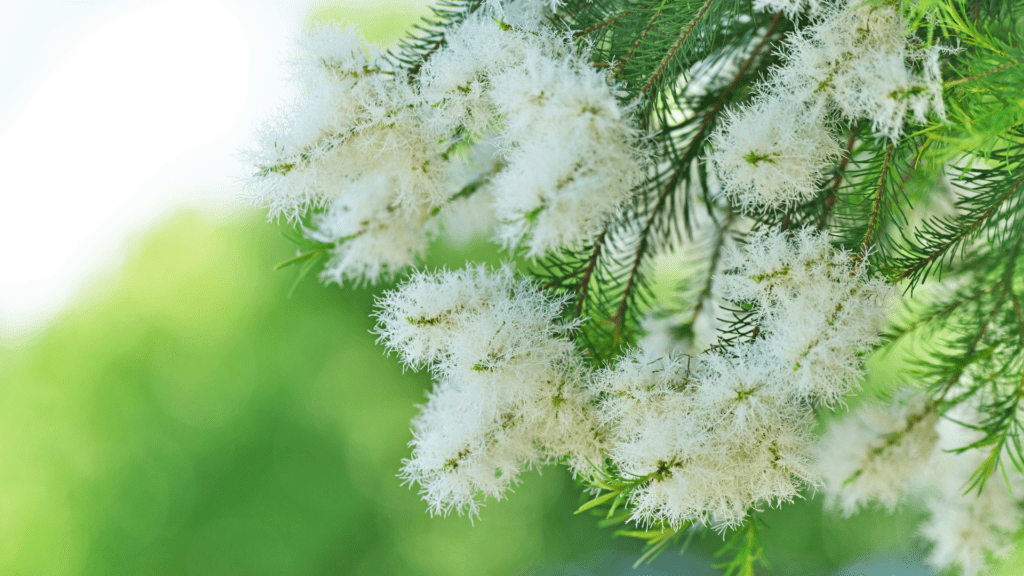Picture the wild landscapes of Australia, where golden sunlight filters through towering eucalyptus trees and the air is rich with the earthy scent of plants. Here, among the marshy coasts and untamed plains, grows a small but mighty tree—the Melaleuca alternifolia, or Tea Tree. This unassuming plant holds a treasure within its slender leaves: a potent essential oil that has been revered for centuries for its almost magical ability to heal, protect, and restore.
A Journey from Australia to the World
Tea Tree’s story begins with the Indigenous Bundjalung people of Australia. Long before the modern world caught on to its wonders, they were steeping its leaves in water to create healing poultices for wounds and infections. Imagine a time when antibiotics didn’t exist—these leaves were their go-to remedy. Inhaling the steam from crushed Tea Tree leaves was their answer to respiratory troubles, and applying it to cuts? A surefire way to prevent infection.
Fast forward to the 18th century, when European explorers arrived in Australia. Intrigued by the locals’ use of the plant, they began brewing the leaves into “tea” (hence the name). Little did they know that centuries later, this plant would be distilled into a global phenomenon, bottled as Tea Tree essential oil and celebrated in homes and medicine cabinets worldwide.
Producing Tea Tree Essential Oil
To unlock Tea Tree oil‘s incredible properties, timing is everything. Farmers wait until the leaves are brimming with essential oil, usually during warm seasons when the sun coaxes the plant into full potency. Harvesting these delicate leaves is both an art and a science—done carefully to ensure the plant continues to thrive.
Once gathered, the leaves are whisked off to distillation facilities. Here, the magic happens: steam is gently passed through the leaves, coaxing the oil to separate and rise. What emerges is a clear, golden liquid that carries the plant’s essence, ready to embark on its journey to heal and protect.
The Historical and Medical Evolution of Tea Tree Oil
Traditional Use by Indigenous Australians
The use of Tea Tree (Melaleuca alternifolia) leaves by Aboriginal Australians represents one of the earliest documented applications of natural medicine. Indigenous communities utilized the leaves to treat a variety of ailments, relying on their antimicrobial properties long before modern science could explain the mechanisms. The leaves were crushed to release their essential oils and applied directly to wounds or used as poultices to prevent infection. Additionally, the leaves were steeped in water to create medicinal infusions for respiratory conditions, such as colds and coughs. The practice of bathing in natural “healing lakes” enriched with decaying Tea Tree leaves further highlights the profound understanding Indigenous Australians had of the plant’s therapeutic potential.
World War II and Medical Advancement
The medical application of Tea Tree oil gained international attention in the early 20th century. Its antiseptic properties were first scientifically documented in the 1920s, leading to its commercial production. During World War II, Tea Tree oil was provided to Australian soldiers as a vital part of their medical kits. Soldiers used it to clean wounds, treat fungal infections, and prevent sepsis, particularly in environments where conventional antibiotics were not readily available. The Australian government deemed Tea Tree oil production so essential to the war effort that workers involved in its harvesting and processing were exempt from military service. The oil’s efficacy during this time earned it the moniker “liquid gold” and solidified its place as a critical antiseptic.
Modern Applications and Research
In contemporary times, Tea Tree oil has transitioned from battlefield medicine to mainstream healthcare and wellness. Modern research has validated many of its traditional uses, attributing its antibacterial, antifungal, and anti-inflammatory effects to compounds like terpinen-4-ol. These findings have expanded its applications, ranging from acne treatment and dandruff management to household cleaning and air purification.
Research supports its antibacterial, antifungal, and anti-inflammatory properties, with limited but promising evidence of antiviral activity. It has demonstrated effectiveness against a wide range of bacteria, including those linked to bacterial vaginosis, and studies suggest it may be useful for vaginal yeast infections caused by Candida albicans.
Tea Tree antimicrobial mechanism involves disrupting cell membranes, impairing glucose respiration, and compromising mitochondrial function, leading to loss of cellular homeostasis. Importantly, Tea Tree has shown activity against antibiotic-resistant bacteria without promoting resistance itself, with one rare exception involving Staphylococcus aureus in laboratory settings.
Its broad-spectrum antimicrobial properties and minimal risk of resistance development underscore its continued relevance in both clinical and everyday settings.
Therapeutic Properties: Why It Works
What makes Tea Tree oil so special? Its rich composition of terpenes—natural compounds that fight bacteria, fungi, and inflammation. It’s a multi-tasker like no other, and here’s what it does best:
– Fights Germs Like a Pro: From stubborn acne to fungal infections, Tea Tree oil takes on bacteria, viruses, and fungi with ease.
– Calms Inflamed Skin: Whether it’s eczema, psoriasis, or an angry bug bite, this oil cools and soothes.
– Speeds Up Healing: Cuts and scrapes? Tea Tree steps in to disinfect and accelerate recovery.
– Freshens the Air: Diffuse a few drops, and its clean, herbaceous aroma doesn’t just smell great—it actively purifies the air.
– Supports Respiratory Health: Feeling stuffy? A whiff of Tea Tree oil clears the airways and helps you breathe easy.
Making Tea Tree Part of Your Everyday Life
Tea Tree oil isn’t just a tool—it’s an experience. Its invigorating scent reminds you of the wild outdoors, while its versatility empowers you to tackle everything from pesky skin issues to household grime. Here are three simple ways to bring it into your routine:
Clear Skin Magic
Ingredients: 1 teaspoon jojoba base oil; 1 drop Tea Tree essential oil
Mix the oils together and gently dab onto blemishes before bedtime. Wake up to calmer, clearer skin!
Breathe Easy Balm
Ingredients: 2 tablespoons sweet almond oil; 3 drops Tea Tree essential oil; 2 drops eucalyptus essential oil
Mix and stir in the oils. Massage onto your chest and neck to ease congestion.
Natural All-Purpose Cleaner
Ingredients: 1 cup water; 1 cup white vinegar; 15 drops Tea Tree essential oil
Combine all ingredients in a spray bottle. Use on countertops, sinks, and other surfaces for a fresh, germ-free shine.
Conclusion
Tea Tree essential oil isn’t just an oil—it’s a story. A tale of resilience, discovery, and the boundless potential of nature. From the ancient wisdom of Aboriginal healers to the modern homes that rely on its power, Tea Tree has earned its place as a timeless remedy. Whether it’s clearing your skin, refreshing your space, or simply connecting you to the natural world, every drop is a reminder of the miracles that grow around us.

